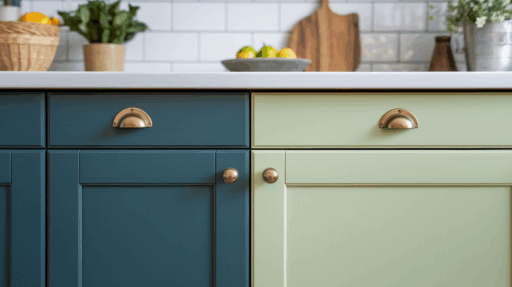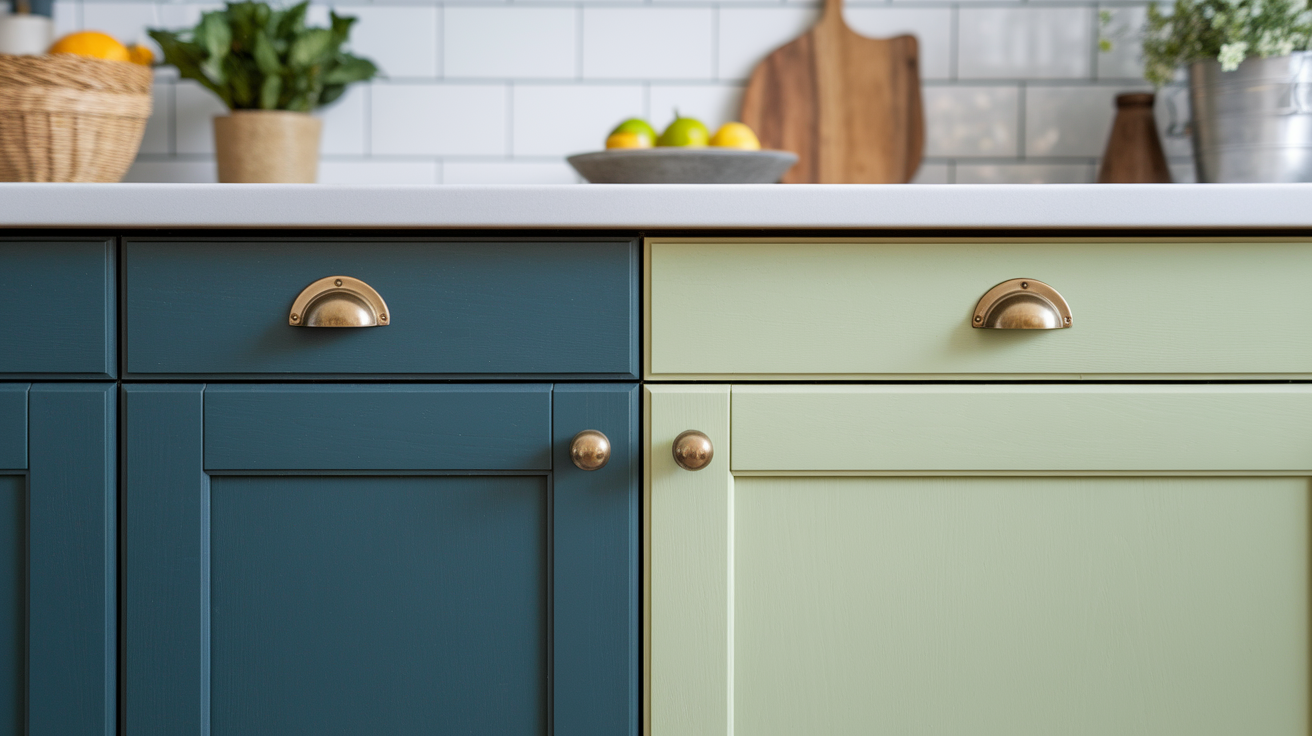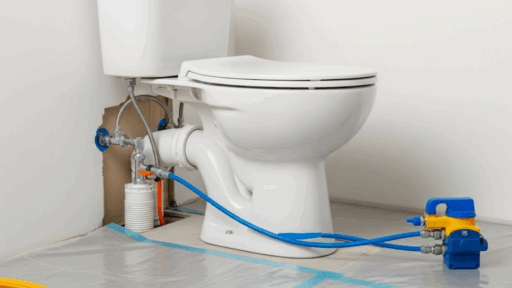Your kitchen cabinets don’t have to be boring. Gone are the days when every cabinet had to match perfectly.
Two-tone kitchen cabinets are changing the game. They mix two different colors or finishes in one space. This creates a look that’s both stylish and personal.
Think white upper cabinets with navy blue lowers. Or natural wood paired with crisp paint. The possibilities are endless.
Why settle for plain when you can have personality? Two-tone cabinets let you show off your style. They make small kitchens feel bigger and large ones more interesting.
Ready to learn how to make it work? Let’s find out everything you need to know about two-tone kitchen cabinets.
What Are Two-Tone Kitchen Cabinets?
Two-tone kitchen cabinets feature two different colors, materials, or finishes within the same kitchen space. This design approach moves beyond traditional single-color cabinetry to create depth, character, and visual contrast.
The technique can involve pairing painted finishes with natural wood, combining light and dark colors, or mixing different materials entirely.
This design flexibility enables homeowners to create kitchens that reflect their personal taste while addressing practical concerns, such as room size, lighting, and the overall style of their home.
Benefits of Two-Tone Kitchen Cabinets
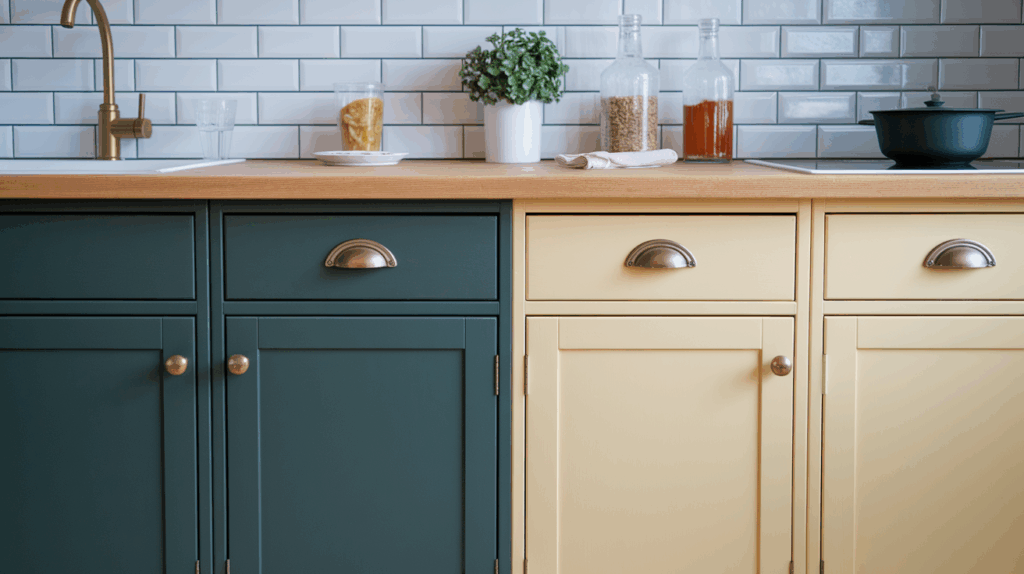
When you choose two-tone cabinetry, you’re opening doors to design possibilities that single-color kitchens simply can’t match. This approach gives you the freedom to experiment with color relationships while maintaining a cohesive look throughout your space.
1. Personalization and Style Expression
Two-tone cabinets offer the chance to create a kitchen that truly reflects your unique personality. You can incorporate favorite colors, complement existing décor, or establish a specific mood through thoughtful color selection.
2. Visual Interest and Depth
Using two different colors creates natural focal points and prevents the kitchen from feeling flat or monotonous. The contrast adds dimension and makes the space feel more intentionally designed.
3. Practical Advantages
Different colors can serve functional purposes. Darker colors on lower cabinets hide scuffs and stains better, while lighter upper cabinets can make the ceiling appear higher and the space feel larger.
4. Increased Home Value
Well-executed two-tone cabinetry often appeals to potential buyers because it demonstrates attention to design detail while remaining adaptable to different decorating styles.
Popular Color Combinations for Two-Tone Kitchen Cabinets
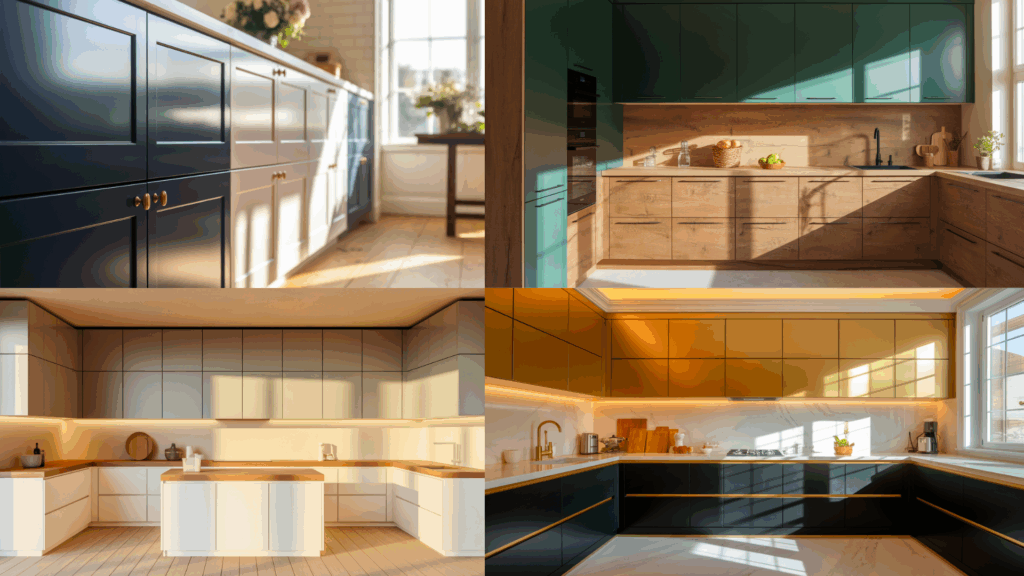
The right color pairing can make or break your kitchen design, so understanding which combinations work well together is essential for success.
From classic contrasts that have stood the test of time to bold statements that reflect current trends, there’s a two-tone combination to suit every style preference.
Classic Pairings
- White and Navy Blue: Creates a fresh, coastal feel that works in both traditional and contemporary kitchens.
- Gray and White: Offers a clean, sophisticated look that complements most home styles
- Cream and Charcoal: Provides warmth while maintaining modern appeal
Bold Statement Combinations
- Black and Brass Accents: Creates drama and luxury
- Forest Green and Natural Wood: Brings nature indoors with an organic feel
- Deep Blue and Warm White: Offers a classic yet striking contrast
Natural Material Mixes
- Painted Upper Cabinets with Wood Lowers: Combines the warmth of natural materials with the crispness of paint.
- Stained Oak with Painted Accents: Maintains traditional appeal while adding contemporary touches
Ideal Cabinet Styles for Two-Tone Designs
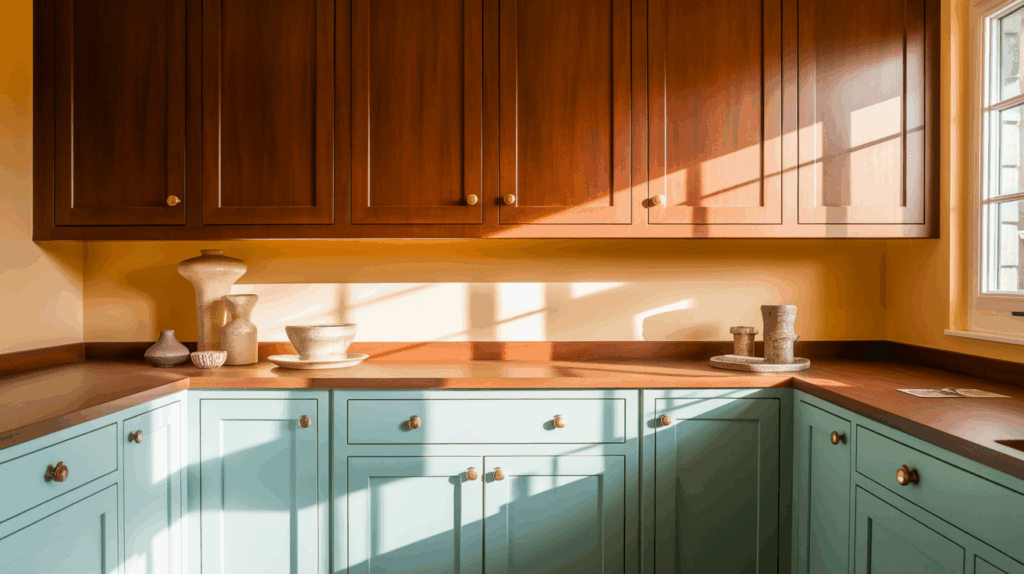
Not every cabinet style works equally well with two-tone treatments, so choosing the right door style is essential for achieving your desired look.
The cabinet door design can either enhance or compete with the color contrast, making style selection a critical part of your planning process.
1. Shaker Style Cabinets
The clean lines and simple design of Shaker cabinets provide an excellent foundation for two-tone applications. The style’s versatility works equally well with traditional and contemporary color schemes.
The recessed panel design creates natural definition between colors, making transitions appear intentional and polished. This timeless door style ensures your two-tone investment will remain stylish for years to come.
2. Flat-Panel Cabinets
Contemporary flat-panel designs excel with two-tone treatments, particularly when using contrasting colors to highlight the sleek, minimalist design.
The smooth, unadorned surfaces allow colors to take center stage without competing with details.
Bold color combinations work particularly well with this style, as the clean geometry can handle dramatic contrasts. These cabinets suit modern homes where simplicity and color create the primary visual impact.
3. Traditional Raised-Panel Cabinets
These work beautifully when combined with natural wood tones and painted finishes, maintaining a classic appeal while adding visual interest. The raised panel detail adds texture that complements the color variation in two-tone designs.
Wood stains on these cabinets pair exceptionally well with neutral paint colors, creating warmth and depth. This combination honors traditional craftsmanship while introducing contemporary color sensibilities.
Strategic Placement of Two-Tone Cabinets
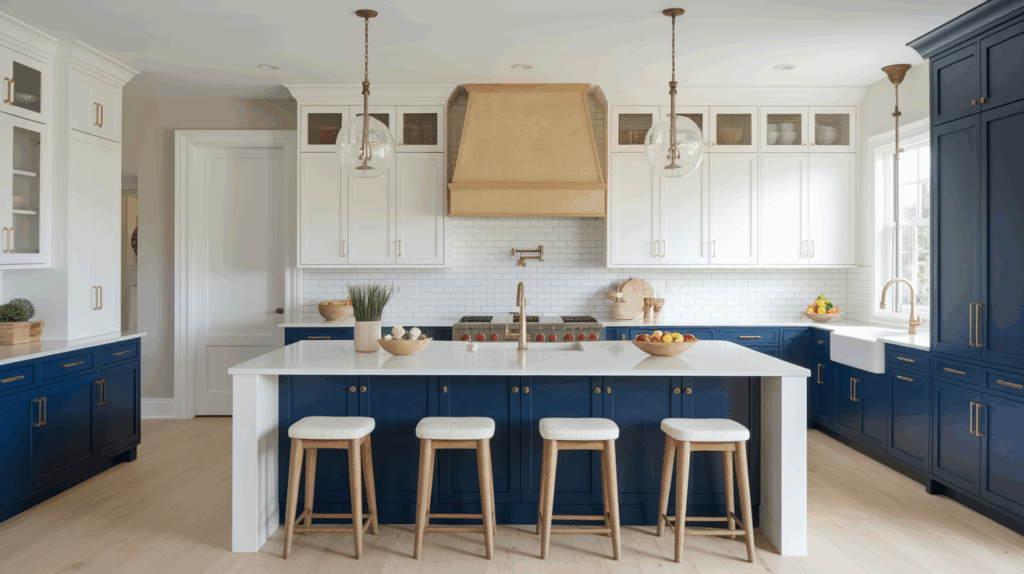
Where you place each color in your kitchen matters just as much as which colors you choose to pair together. Thoughtful placement creates visual flow and establishes focal points that guide the eye naturally around the space.
Upper vs. Lower Cabinet Contrast: The most common approach involves using lighter colors on upper cabinets and darker colors on lower cabinets. This creates visual weight at the bottom while maintaining an open and airy feel in the upper portion of the kitchen.
Kitchen Island as Focal Point: Using a contrasting color on the kitchen island creates a natural focal point while keeping the perimeter cabinets in a more neutral tone. This approach works particularly well in open floor plans.
Mixed Integration with Open Elements: Combining two-tone cabinets with open shelving allows you to introduce color while maintaining visual lightness and enhancing display opportunities.
Tips for Choosing the Right Two-Tone Combination

Selecting the perfect two-tone combination requires careful consideration of multiple factors that influence how colors will look and feel in your specific space.
Consider Room Size and Natural Light: Smaller kitchens benefit from lighter color combinations that reflect light and create an open, airy feeling. Larger kitchens can handle darker, more dramatic color contrasts without feeling cramped.
Coordinate with Existing Elements: When selecting cabinet colors, consider your countertops, backsplash, and flooring to ensure a cohesive look throughout your space.
Balance is Key: When using bold colors, balance them with neutral tones. If you choose a vibrant color for your island, consider keeping the perimeter cabinets in a more subdued tone.
Test Before Committing: Always view color samples in your actual kitchen space under various lighting conditions. Colors can appear dramatically different under various lighting situations.
Pro Tip: Create large sample boards (at least 12×12 inches) and observe them in your kitchen for a week under different lighting conditions before deciding.
Common Mistakes to Avoid
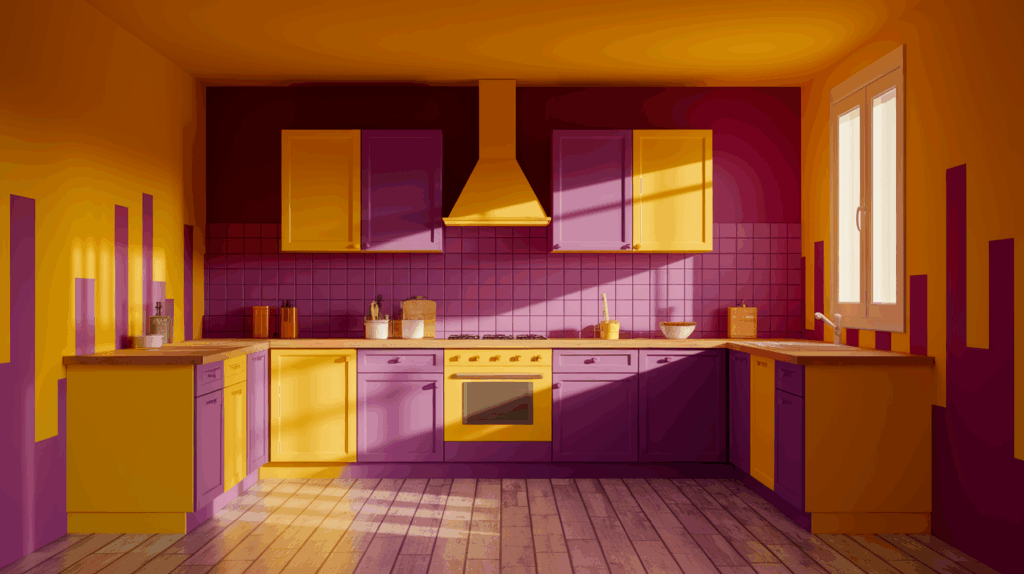
Even with the best intentions, inevitable missteps can undermine the success of your two-tone cabinet project. Learning from these common pitfalls will help you make better decisions and achieve the polished, professional look you’re after.
- Color Harmony – Choose colors that work together and match your kitchen style
- Clever Placement – Plan color placement thoughtfully; dark colors show fingerprints more
- Neutral Countertops – Use white quartz or butcher block to complement both cabinet colors
- Coordinated Hardware – Brushed gold for warm tones, brushed nickel for cool tones.
Two-Tone Cabinets in Different Kitchen Sizes
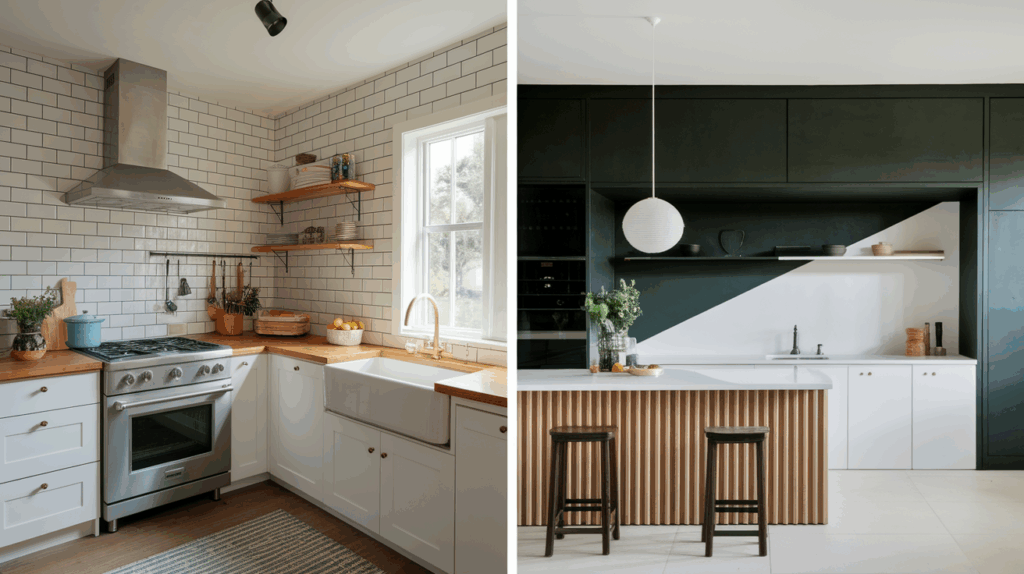
The size of your kitchen plays a crucial role in determining which two-tone combinations will work best for your space.
Understanding how color choices affect the perception of space can help you make decisions that enhance rather than hinder your kitchen’s natural proportions.
Small Kitchens
In compact spaces, use lighter colors on upper cabinets to maintain an open feeling. Reserve darker colors for lower cabinets or a small island if space permits. This approach helps draw the eye upward and creates the illusion of height and spaciousness.
Large Kitchens
Spacious kitchens can accommodate more dramatic color contrasts and multiple focal points. Consider using different color combinations in different zones of a large kitchen.
The extra square footage allows you to experiment with bolder choices without overwhelming the space.
Real-Life Applications and Inspiration
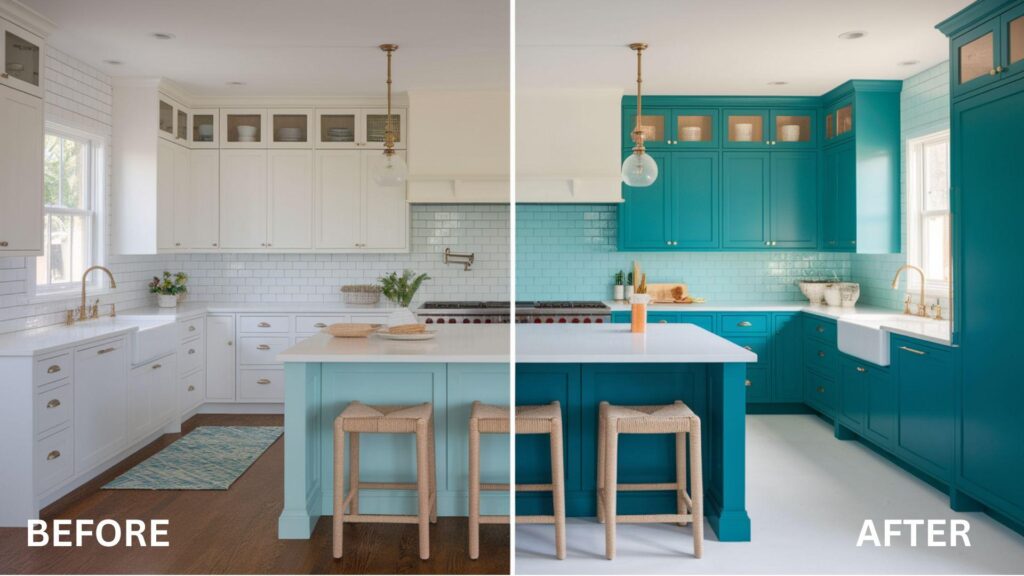
Two-tone cabinetry works across various design styles:
Farmhouse Style: White upper cabinets paired with sage green lowers create a fresh, country feel.
Contemporary Design: Charcoal gray lowers with white uppers provide a clean, modern contrast.
Traditional Elegance: Natural cherry wood lowers with cream-painted uppers maintain classic sophistication.
Coastal Style: A navy blue island with white perimeter cabinets evokes a seaside charm.
Is Two-Tone Cabinetry Right for Your Kitchen?

Consider these factors when deciding if two-tone cabinets suit your space:
Style Preferences
Do you prefer clean, simple designs, or do you enjoy more visually complex ones? Two-tone cabinets add complexity that some prefer, while others find overwhelming.
Consider how this design choice will complement your overall home décor and personal taste preferences.
Budget Considerations
Two-tone cabinetry may involve additional costs for paint, stain, or materials. However, the investment often pays off in increased home value and personal satisfaction.
Factor in both immediate costs and long-term value when making your decision.
Long-term Appeal
Choose color combinations that will remain appealing over time. Trend-based colors may date quickly, while classic combinations maintain their appeal for years.
Consider how your color choices will look in your home five to ten years from now.
Professional vs. DIY Installation
While DIY installation is possible for experienced homeowners, professional installation ensures proper color matching and high-quality finishes.
Evaluate your skill level honestly and consider the complexity of achieving consistent results across all cabinet surfaces.
Bringing Your Two-Tone Vision to Life
Two-tone kitchen cabinets represent more than just a design trend – they’re an invitation to create a space that truly feels like home.
Success in two-tone design hinges on intentional choices. From selecting harmonious color pairings to considering how natural light plays across different finishes, every decision contributes to the final result.
Even if you’re drawn to subtle contrasts that whisper class or bold combinations that make a confident statement, two-tone cabinets can accommodate your vision.
With thoughtful planning and careful execution, you’ll soon have a kitchen that perfectly balances beauty, personality, and function.

